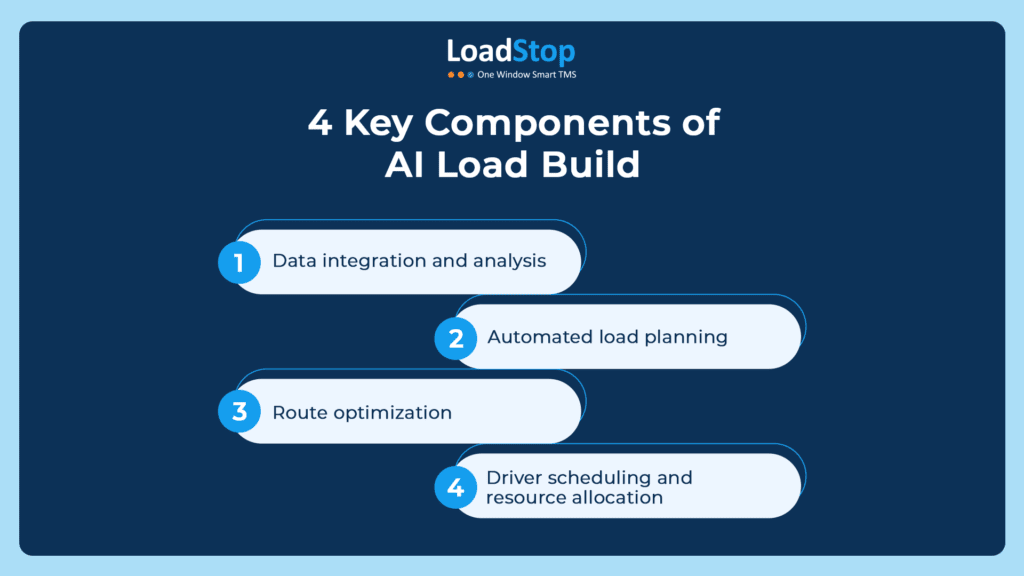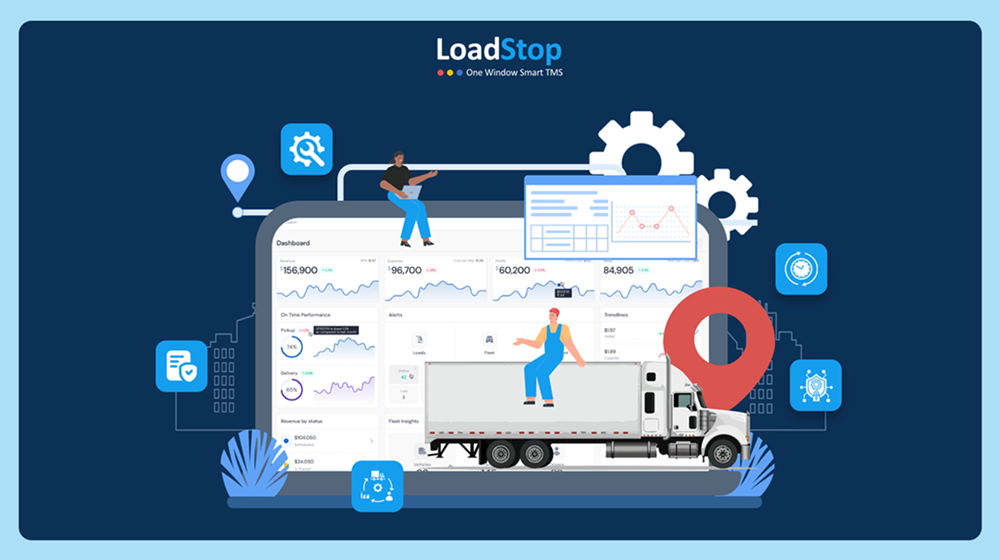As AI-powered tools continue to grow, dispatchers and fleet managers need to streamline the load creation process. But what is the role of AI technology and how does it affect operations? Whether you are struggling with load assignments or have to deal with empty miles, AI Load Build is one handy solution. Truckers now can leverage the power of artificial intelligence to optimize load distribution and focus on route planning and fleet management.
Using AI-based trucking dispatch software is crucial to automating once manual tasks, such as driver scheduling or real-time tracking. Let’s take a look at how AI Load Build can help businesses achieve their goals.
What is AI Load Build
One of the core functionalities in freight focuses on load building. The main aim of load build is to plan the most economical and efficient way to move items from your warehouse to the customer, from your supplier to your warehouse, or from a supplier directly to your client.

As an alternative, you can utilize the AI Load Build feature to move items between your warehouses, from the warehouse to the production area, and vice versa.
Load build is dependent on the freight orders so to plan the transportation of goods, you need to select freight orders. This is where load planning comes into play. However, the trucking industry is more complex, and manual load planning and dispatchers are not efficient anymore. Companies now want to handle a large volume of shipments for on-time deliveries which is why AI Load Build transforms these manual processes and makes the operation more efficient. It optimized the entire supply chain and also provided real-time insights.
Role of AI in Optimizing Load Distribution
According to a McKinsey report, companies integrating AI-driven logistics have seen a 10-2% increase in performance and expect a gain of up to 40% within 2 to 4 years. Artificial intelligence is the key ingredient to optimizing load distribution in the transportation industry. Utililizing advanced algorithms and machine learning practices companies can better decide load distribution, how loads are assigned, routes are planned and trucks are utilized.
The AI TMS software will analyze the large dataset from multiple sources such as traffic conditions, fuel consumption, vehicle performance, and delivery schedule. Companies can identify and minimize the empty miles, reduce the number of trips, and allocate loads more efficiently.
AI algorithms help to update and optimize the delivery routes based on real-time insights like traffic congestion, weather conditions, and road closures. Similarly, shipments are identified based on the size, weight, location, and the deadline. It helps to make the logistic process more cost-effective for the trucking companies.
4 Key Components of AI Load Build
Different components work together to optimize the load planning and dispatching process. AI Load Build ensures that loads are allocated, routed, and delivered with the help of:

1. Data integration and analysis
Companies depend on data integration and analysis to get updated data from multiple sources like customer orders (order size and timelines), fleet availability (status, location, use of vehicle), and traffic patterns (road closures) that can affect the delivery routes. The machine learning algorithm, predicts the delivery times more accurately so that you can optimize the load combination and figure out a way in case of potential delays.
2. Automated load planning
Automation load planning is a critical component of AI Load Build that helps determine the load size and weight without compromising the capacity of the fleet. It also helps to optimize the delivery sequence to further optimize travel distance and time. Shipments can be easily prioritized if they have tighter deadlines to meet customer expectations.
3. Route optimization
Continuous updates help identify and focus on the delivery routes. Thanks to the real-time tracking data, you can keep a close eye on the congestion levels, accidents, or road closures that can impact the delivery. With AI Load Build you can find alternative routes to avoid any unexpected disruptions, and reassess the routes to make urgent deliveries on time.
4. Driver scheduling and resource allocation
Drivers are usually overworked due to their tight schedules year-round. From September to December, during peak season challenges are faced by the drivers. Using an advanced feature component like driver scheduling you can take the driver preference and skillset into account, and plan their schedule in a better way so that they are tired when en route. It will help maximize productivity to ensure safety standards are met, reducing the chance of accidents.
How AI Load Build System Helps Fleet Management
AI Load Build system integration in fleet management dramatically boosts total logistics performance, lowers expenses, and increases efficiency. Let’s take a look at the ways it helps fleet management:

Fleet efficiency with tracking
Imagine if your truck is stuck in traffic due to an accident. The AI Load Build system will detect the delay and re-route other trucks to avoid the congested area. It will ensure timely deliveries and give a 10-20% improvement in the efficiency of fleets as well.
Improved communication with dispatchers and drivers
Sometimes, the delivery schedule can change last minute at the customer’s request. In such a case it is seen that AI-driven communication tools help to minimize order delays without manual intervention reducing miscommunication errors by 30%. So AI Load Build automatically updates the driver and dispatcher to keep them informed about delivery changes.
Real-time data insights
If there is a trend of late deliveries but persistent on a specific route, fleet managers can use the AI insights to analyze the root cause for it – whether it’s due to traffic or inefficient route planning, adjustments are made easily.
Lower fuel consumption
The AI technology rapidly determines alternative, less fuel-intensive paths if a truck’s original route becomes extremely clogged, lowering total operating expenses. By avoiding traffic jams and determining the most effective delivery routes, AI Load Build systems can optimize routes and save fuel. Businesses have experienced fuel cost reductions of up to 15% when utilizing AI-based route optimization technologies, which directly reduces their carbon footprint.
Enhanced customer satisfaction
Customer satisfaction is greatly increased by AI Load Build systems’ precise tracking information and on-time deliveries. Consumers value timely product delivery and understanding the precise status of their shipments.
Customers who are anticipating a crucial delivery are provided with up-to-date information on the status of their shipment, which gives them a precise idea of when it will arrive. With the customer, this openness fosters dependability and trust.
Lower shipping and delivery costs
By reducing empty kilometers and increasing vehicle utilization, AI Load Build systems optimize load planning and route management, which immediately lowers shipping and delivery costs.
By combining several smaller shipments into a single truckload, a logistics company can make efficient use of the vehicle’s capacity and cut down on the number of trips needed.
Balanced workloads
By distributing workloads fairly across drivers, AI Load Build helps to avoid burnout and guarantees that each driver has a sustainable schedule. Higher driver satisfaction and lower turnover rates are the results of this balancing.
The AI system evenly divides assignments according to driver availability, permitted driving hours, and rest needs rather than overloading one driver with successive long hauls.
Benefits of Integrating AI into Trucking Dispatch Systems
Artificial intelligence (AI) is revolutionizing the logistics sector by increasing the effectiveness and productivity of trucking dispatch systems.
1. Increased efficiency
AI-powered dispatch systems use data-driven algorithms to expedite the load allocation and route planning processes. Delays are decreased and pointless paths are eliminated as a result of this automation, which also speeds up decision-making and increases resource efficiency.
An AI dispatch system, for instance, may automatically create the most effective routes in a matter of seconds, accounting for factors like traffic, weather, and delivery windows, in place of manually designing each delivery route. This guarantees that the fleet runs as efficiently as possible with little downtime.
2. Higher productivity
Trucking businesses may concentrate more on growth-oriented strategic operations when AI technology takes care of the monotonous load management and scheduling responsibilities. Because human resources may now focus on higher-value jobs, overall productivity is increased.
Instead of being constrained by manual scheduling and tracking, dispatchers can utilize their time to evaluate performance data and create plans for enhancing the company.
3. Reduced manual workload
Automating time-consuming operations is one of the major benefits of incorporating AI into trucking dispatch systems. AI reduces dispatchers’ burden and minimizes human mistakes by doing away with the necessity for repetitive scheduling procedures and manual data entry.
Without continual supervision, AI systems may automatically organize and allocate loads to drivers according to their availability and permitted driving hours, guaranteeing compliance and effective resource usage.
4. Real-time decision making
Trucking businesses may instantly modify routes, delivery schedules, and load assignments thanks to AI’s real-time data processing and analysis capabilities. This flexibility is essential for managing unanticipated circumstances such as traffic jams or last-minute modifications to delivery requirements.
The AI system can immediately reroute a truck in the event of a road closure, reducing delays and guaranteeing that the delivery timetable is met.
Reduce Dispatch Errors with Cloud-based TMS Software
More than just a technical advancement, integrating AI into trucker dispatch systems is a revolutionary move that completely changes how logistics firms function. Trucking firms may reduce manual labor and operational errors while increasing production, and efficiency, and making better real-time decisions by utilizing AI-powered technologies.
Loadstop’s cutting-edge AI Load Build technology allows trucking businesses to control dispatch with unprecedented precision. Imagine a system that balances workloads to guarantee optimal productivity, not only organizes your routes with extreme precision but also adapts dynamically to changing conditions.
Optimize smarter, and deliver faster with AI Load Build
Book Your Demo NowFAQs
It is a software designed for trucking brokerage, and 3PI companies to help them streamline their supply chain operations.
Trucking dispatch software like LoadStop improves fleet management by automating processes, optimizing routes, enhancing communication, and making quick adjustments.
Route optimization is a key component of the AI Load Build feature. It also tracks shipments in real time and adjusts in case of delays, thus improving the delivery time.



